It’s that time of year once again, when many folks around the world will begin to decorate for the holiday season. Glass has played an interesting role in these decorative traditions, and, here at The Corning Museum of Glass, we hope to shed light on how these glass ornaments are made.
The glass Christmas ornament has its origins in the town of Lauscha, Germany. Lauscha, a small town set in the Thuringian forests of eastern Germany, was founded in the late 16th century by a pair of glassmaking families. The Greiner and Müller families moved from Swabia in what is now southwestern Germany to escape religious persecution. In 1597, they were granted permission from the Duke of Sachsen-Coburg to build a glass factory in Lauscha.

The factory in the center of Lauscha that still supplies the tubing and rod from which the locals make their wares.
Glassmaking requires a few key ingredients, and the Thuringian region had good silica-sand, soda ash, and limestone in abundance, as well as having very dense forests of trees to fire the furnaces. The Greiner and Müller families began producing tableware, flasks, and beads in the factory (or glasshütten) for the first 200 years of Lauscha’s glass age.
Eventually, the population and production levels grew beyond what the walls of the factory could handle, and a cottage industry was born. The factory continued its standard production items, but they also began to produce rods and tubes that the villagers would bring home to re-shape over their own lampworking set-ups.
Prior to the development of glass ornaments, Christmas trees were often decorated with fruits and nuts, amongst other decorations. Legend suggests that in one particular year, drought had greatly reduced food supplies and fruits and nuts were much tougher to attain.
One ingenious glassmaker found a way to supplement the lack of fruits and nuts with glass versions to decorate his tree. In 1847, Hans Greiner began producing glass pieces in the shapes of fruits and nuts to be used as ornaments for his Christmas tree, and a new tradition was born.

The first-year students at the glass school in Lauscha still begin their studies by learning the ornament tradition.
Basic fruit and nut shapes are simple enough to produce freehand on the torch or lamp, but to mass-produce more complex forms, the Lauschans developed a mold-blowing technique that is still in use today.
I was fortunate enough to visit Lauscha last year, and I learned quite a bit about the process from 4th generation ornament-maker Michael Haberland. The first molds were carved from wood, but they were quickly replaced by ceramic molds. The ceramic molds are still the most common today.
To demonstrate the process for our visitors here at CMoG, we have fabricated our own two-part mold-blowing rig, and we have created a few simple molds.
Our mold-blowing rig is fashioned after the simplest spring-loaded rigs I was shown at the glass school in Lauscha. Some of the ornament makers there are now using machine-driven mold rigs, but the spring-loaded version still works just fine. We created a few molds directly from other ornaments by pouring a plaster-silica mix over them. The plaster-silica mix hardens in a few minutes and fully cures over a couple of days. Then the molds are ready to use.
A novice may tend to think that blowing these forms with the help of a mold would be very simple, but it actually requires quite a bit of skill. The glass tubing must be just the right size, shape, and temperature to achieve the desired result.
Some of the molds have very intricate shapes and textures. The glass will not properly fill the mold if all factors are not met at the same time.
- Half of the mold box is filled with clay, and the ornament is depressed halfway into the clay.
- The top half of the mold box is filled with the plaster/silica mix. Then, the mold box is flipped. The clay is removed, and the other half of the mold box is filled with the plaster/silica mix.
- Finished molds
Once the glass has been blown into the mold and cooled, the decoration process begins. The first step in decorating the ornament is to silver or mirror the inside with a silver nitrate and sugar water solution. This silvering process guarantees the reflective qualities that allow the ornament to glow brightly on the tree. Once they are silvered on the inside, the ornaments are further decorated with painted-on lacquers, and other decorations such as glitter and feathers may be attached with glue. A metal cap is attached, and the ornament is finished.
- Blowing into the bird mold…
- Bird fresh out of the mold…
If you would like to witness the mold-blowing process in person, please come by for one of our Flameworking Demos here at The Corning Museum of Glass which we offer all day, every day. We will be performing at least one of these ornament demos every day between December 6 and December 31.



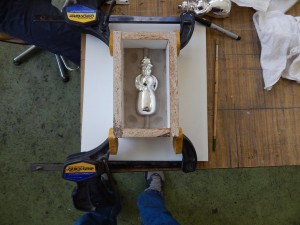
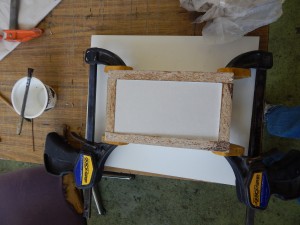
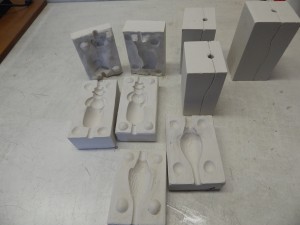
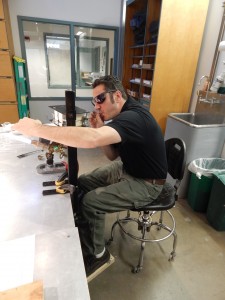
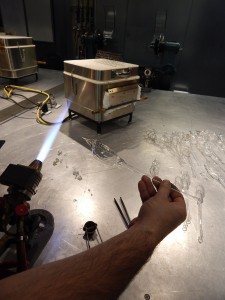
8 comments » Write a comment